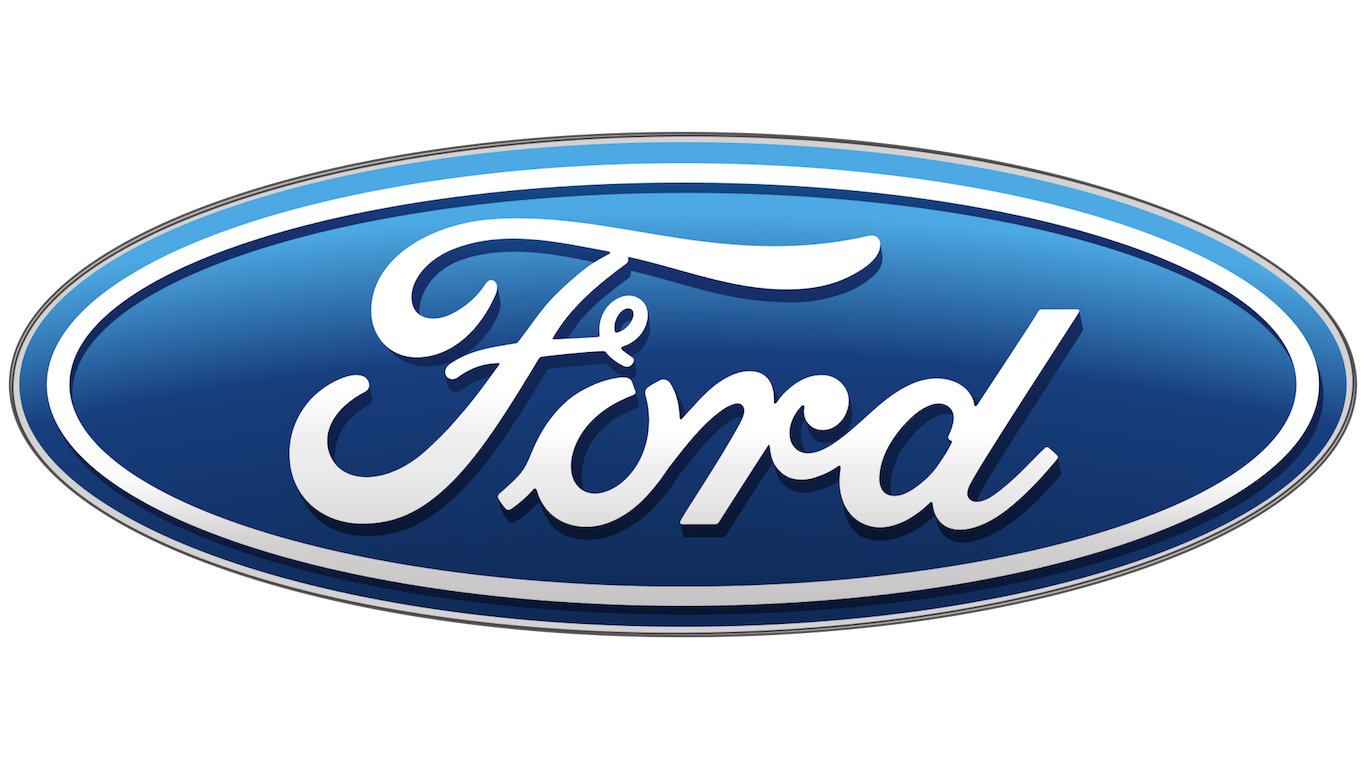

Ford Motor Co. (NYSE: F) has struggled to find a formula to fix the company under new CEO Jim Hackett. However, this has been made harder, as sales in China have fallen. Its critical move into electric cars is complicated by competition led by Tesla. The headwinds and slow reactions of management to the market beg the question of who will set the course for Ford’s future.
Ford’s Recent Troubles
The Ford Motor Company was founded in 1903. Today, it faces more challenges than in almost any period in its past as its sales decline worldwide. It has largely left the car market in the United States because of a drop in popularity of sedans and coupes, while the demand for sport utility vehicle sales, crossovers and pickups has risen.
In the meantime, Ford car sales in China, the world’s largest car market, have dropped precipitously. Its sales fell in the world’s most populous country, off 26% to 567,854. In contrast, the Tesla Inc. (NASDAQ: TSLA) stock price has risen to record levels recently, largely because of promising early results in the People’s Republic.
Tesla’s market cap is now double that of Ford and General Motors Co. (NYSE: GM) combined. This is extraordinary since Tesla sells a fraction of what Ford and GM do each year. Market capitalization is the best metric to evaluate what Wall Street thinks of a public corporation.
Vehicle sales have not been Ford’s only problem. The sales slump has occurred at the same time it has struggled to move into the wildly competitive autonomous (self-driving) and electric vehicle (EV) segments.
Hackett, former head of Ford Smart Mobility, promised an $11 billion restructuring shortly after he took over in 2017. The plan has triggered layoffs, which includes 10% of its global white-collar workforce. However, it has not delivered on future EV and autonomous initiatives.
Ford’s only real visible start into the EV market, so far, is the Mustang Mach-E crossover. It will not be available until late this year. Ford says it has a number of reservations for the vehicle, though it has not given an official number. Among the Mustang Mach-E’s several attractive features is a range of up to 300 miles on one battery charge. That is near the outer limit of most of the competition.
Ford’s bet on electric cars in general may be more than it can deliver. Management says it will have 40 electrified vehicles in the market by 2022. However, some of these will be hybrids. That cuts the number of its cars that will compete directly with Tesla. Other larger car manufacturers have announced all-electric vehicles too. The market is remarkably competitive.
The same level of competition holds true for autonomous vehicles. Additionally, technology titans like Alphabet have initiatives of their own. While auto giants like Hyundai and Honda have projects to put vehicles that don’t need human drivers onto the road, so have the tech giants. The most well known of them is Waymo, Alphabet’s autonomous car subsidiary.
It is hard to make the case that Ford is not trying to win the innovation game. It was among the top 50 U.S. patent assignees. The official name of the company that received the patents was Ford Global Technologies.
How the Market Has Reacted
Ford’s stock is down 38% in the past five years. The stock market, as measured by the S&P 500, is up 58% over the same period. The stock price of GM has risen 4% in that time.
Among the reasons Ford stock has been moderately attractive is that it has a 6.4% yield, based on a dividend of $0.60 per share. Dividend stocks are often considered safe harbors for people concerned about a market sell-off.
People’s Republic of China
Ford’s most profound failure is its inability to capitalize on the Chinese market, which had grown rapidly until recently. The challenge is particularly problematic now that vehicle sales in the People’s Republic have begun to fall. For most of this century, sales in China rose so rapidly that it passed the United States in terms of total sales in 2009.
Total car sales across all manufacturers dropped 8.2% last year to 25.8 million in China. This remains much larger than in the United States, where sales have hovered around 17 million for five straight years. Ford’s particular problem is that its market share is falling in a shrinking Chinese market. The second-largest car company’s unit sales dropped 25.1% to 567,854 last year.
In 2012, Ford announced it would build a plant in eastern China at a cost of $760 million. More recently, with partner Zotye, it said it would invest another $756 million in an electric car plant. As Ford pours more capital into the market, it comes under increasing pressure to show results.
Investors could hardly be comforted by the comments of Anning Chen, president and CEO of Ford Greater China, who described that falloff: “While our sales declined primarily in the value segment, the decline continued to narrow in the second half and saw the stabilization of our shares in the high-to-premium segments.” In other words, things are getting less bad.
Who Runs Ford?
William Clay Ford Jr., the great-grandson of founder Henry Ford, primarily handles the Ford family’s interests. He has been chair of the company’s board since 1999 and currently holds the title of Executive Chairman.
Ford has had five chief executive officers since then. Ford himself was CEO from October 30, 2001, to September 5, 2006. The current CEO, Jim Hackett, has held the job since 2017.
Who runs Ford is open to interpretation. Hackett does not report to the board. He reports to Bill Ford, according to the press release the company issued when Hackett took the “top” job. Moreover, the Ford family owns about 40% of Class B shares, which gives it effective control over the company.
Aside from Bill Ford and Hackett, the board membership includes Edsel Ford II. Each Ford director earned over $300,000 in 2018. Hackett’s compensation that year was just over $17 million. Bill Ford’s was almost $14 million. Over the three years that ended in 2018, Ford has made $42 million.
What’s Next?
Ford’s revenue has been relatively flat in the past three years at about $159 billion. However, net income has fallen sharply from $7.6 billion in 2016 to $1.6 billion over the trailing 12 months. Ford is asking investors to look long term. Its forecasts for the near term are lackluster.
Ultimately, Ford has some very high hurdles. First, with car sales flat in the United States, weak in much of Europe and falling in China, the only way to increase unit sales is to capture market share.
In the market for passenger cars, Ford has formidable competition. This includes, in particular, GM, Toyota, Volkswagen, Fiat Chrysler, Hyundai and Honda. Each has product development capacity as good as or better than Ford’s.
Ford’s high-end brand, Lincoln, trails BMW, Mercedes, Audi and Lexus in the United States. It also competes with most of these in China and other markets.
The electric and autonomous car markets will require massive amounts of capital. The science behind each is complicated and requires large numbers of highly technical staff. While some large tech companies, led by Alphabet, are focusing on the entire car, from software to powerplant to interior features, others have a more narrow focus.
Apple, for example, has a laser-like focus on infotainment systems. Microsoft’s focus is on software integration. Still others have focused on the manufacturing of cars via robotic products.
Finally, there is also the hurdle of public acceptance of new car tech. Some research indicates that, for now at least, people want to drive cars themselves. Additionally, they prefer gasoline-powered engines.
Sponsored: Want to Retire Early? Start Here
Want retirement to come a few years earlier than you’d planned? Orare you ready to retire now, but want an extra set of eyes on your finances?
Now you can speak with up to 3 financial experts in your area for FREE. By simply clicking here you can begin to match with financial professionals who can help you build your plan to retire early. And the best part? The first conversation with them is free.
Click here to match with up to 3 financial pros who would be excited to help you make financial decisions.
Thank you for reading! Have some feedback for us?
Contact the 24/7 Wall St. editorial team.



